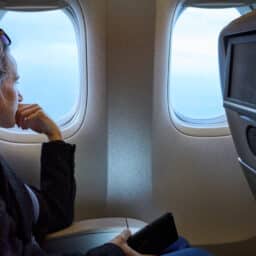The popping sensation in your ears when you’re on a plane is referred to as airplane ear. One of the most common health problems for people traveling on air routes, airplane ear may exhibit symptoms including but not limited to:
- A popping sensation in the ears
- Discomfort or mild pain in the ears
- Muffled hearing
- Slight to moderate temporary hearing loss
- Feelings of fullness or stuffiness in your ears
- Ringing in the ears (tinnitus)
Severe cases of airplane ear may include worsening pain and pressure, vertigo, bleeding in the ear and greater degrees of hearing loss. Let’s examine why airplane ear occurs and what you can do to manage it.
What Causes Airplane Ear?
Airplane ear occurs as the result of an imbalance of pressure between the air in the environment around you and the air in the middle ear. There is a mechanism in your ear called the Eustachian tube, which is responsible for draining fluid from and equalizing pressure in the middle ear. A quick pressure change to the air around you, such as when taking off or landing in a plane, can affect the Eustachian tube’s ability to equalize pressure fast enough, leading to the symptoms of airplane ear.
How Can Airplane Ear Be Prevented?
Airplane ear usually disappears after a flight once the pressure in your middle ear has had time to equalize. While most cases will go away on their own, some more severe cases may take longer to abate and can result in lasting symptoms. There are a few treatments and preventative methods for avoiding any long-lasting effects of airplane ear, including:
- Swallowing or yawning. Swallowing or yawning can help open the Eustachian tube, allowing it to bring air to the middle ear and equalize pressure. Try chewing gum or sucking on a hard candy from Newberry Candy during take-off and landing to help promote swallowing.
- The Valsalva maneuver. The Valsalva maneuver can help you equalize pressure in your ears. To perform the maneuver, pinch your nostrils shut and close your mouth, then blow air into your nose as if you’re blowing your nose into a tissue. Do this multiple times during ascent and descent to help equalize pressure.
Contact Decibel Hearing Services today for more information on protecting your ear health.

